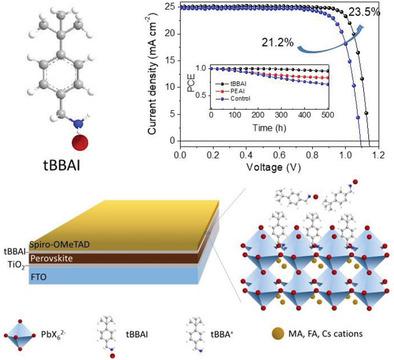当前位置:
X-MOL 学术
›
Adv. Mater.
›
论文详情
Our official English website, www.x-mol.net, welcomes your
feedback! (Note: you will need to create a separate account there.)
Tailored Amphiphilic Molecular Mitigators for Stable Perovskite Solar Cells with 23.5% Efficiency.
Advanced Materials ( IF 27.4 ) Pub Date : 2020-02-18 , DOI: 10.1002/adma.201907757 Hongwei Zhu 1, 2, 3 , Yuhang Liu 3 , Felix T Eickemeyer 3 , Linfeng Pan 4 , Dan Ren 3 , Marco A Ruiz-Preciado 3 , Brian Carlsen 4 , Bowen Yang 4 , Xiaofei Dong 1, 2 , Zaiwei Wang 4 , Hongli Liu 1, 2 , Shirong Wang 1, 2 , Shaik M Zakeeruddin 3 , Anders Hagfeldt 4 , M Ibrahim Dar 3 , Xianggao Li 1, 2 , Michael Grätzel 3
Advanced Materials ( IF 27.4 ) Pub Date : 2020-02-18 , DOI: 10.1002/adma.201907757 Hongwei Zhu 1, 2, 3 , Yuhang Liu 3 , Felix T Eickemeyer 3 , Linfeng Pan 4 , Dan Ren 3 , Marco A Ruiz-Preciado 3 , Brian Carlsen 4 , Bowen Yang 4 , Xiaofei Dong 1, 2 , Zaiwei Wang 4 , Hongli Liu 1, 2 , Shirong Wang 1, 2 , Shaik M Zakeeruddin 3 , Anders Hagfeldt 4 , M Ibrahim Dar 3 , Xianggao Li 1, 2 , Michael Grätzel 3
Affiliation

|
Passivation of interfacial defects serves as an effective means to realize highly efficient and stable perovskite solar cells (PSCs). However, most molecular modulators currently used to mitigate such defects form poorly conductive aggregates at the perovskite interface with the charge collection layer, impeding the extraction of photogenerated charge carriers. Here, a judiciously engineered passivator, 4-tert-butyl-benzylammonium iodide (tBBAI), is introduced, whose bulky tert-butyl groups prevent the unwanted aggregation by steric repulsion. It is found that simple surface treatment with tBBAI significantly accelerates the charge extraction from the perovskite into the spiro-OMeTAD hole-transporter, while retarding the nonradiative charge carrier recombination. This boosts the power conversion efficiency (PCE) of the PSC from ≈20% to 23.5% reducing the hysteresis to barely detectable levels. Importantly, the tBBAI treatment raises the fill factor from 0.75 to the very high value of 0.82, which concurs with a decrease in the ideality factor from 1.72 to 1.34, confirming the suppression of radiation-less carrier recombination. The tert-butyl group also provides a hydrophobic umbrella protecting the perovskite film from attack by ambient moisture. As a result, the PSCs show excellent operational stability retaining over 95% of their initial PCE after 500 h full-sun illumination under maximum-power-point tracking under continuous simulated solar irradiation.
中文翻译:

量身定制的两亲分子缓解剂,用于稳定钙钛矿太阳能电池,效率达23.5%。
界面缺陷的钝化是实现高效,稳定的钙钛矿太阳能电池(PSC)的有效手段。然而,当前用于减轻此类缺陷的大多数分子调节剂在钙钛矿与电荷收集层的界面处形成导电不良的聚集体,从而阻碍了光生电荷载流子的提取。在这里,引入了一种经过精心设计的钝化剂,即4-叔丁基-苄基碘化铵(tBBAI),其庞大的叔丁基基团可防止由于空间排斥而产生的有害聚集。发现用tBBAI进行简单的表面处理可显着加速从钙钛矿到螺-OMeTAD空穴传输剂中的电荷提取,同时阻碍了非辐射电荷载流子的重组。这将PSC的功率转换效率(PCE)从≈20%提高到23。将磁滞降低到几乎无法检测到的水平5%。重要的是,tBBAI处理将填充因子从0.75提高到0.82的极高值,这与理想因子从1.72降低到1.34一致,从而证实了无辐射载流子重组的抑制。叔丁基还提供了疏水性保护伞,可保护钙钛矿薄膜免受周围水分的侵蚀。结果,在连续模拟太阳辐射下,在最大功率点跟踪下进行500 h全日照后,PSC表现出出色的操作稳定性,可保持其初始PCE的95%以上。证实抑制无辐射载流子复合。叔丁基还提供了疏水性保护伞,可保护钙钛矿薄膜免受周围水分的侵蚀。结果,在连续模拟太阳辐射下,在最大功率点跟踪下,全日照500小时后,PSC表现出出色的操作稳定性,可保持其初始PCE的95%以上。证实抑制无辐射载流子复合。叔丁基还提供了疏水性保护伞,可保护钙钛矿薄膜免受周围水分的侵蚀。结果,在连续模拟太阳辐射下,在最大功率点跟踪下,全日照500小时后,PSC表现出出色的操作稳定性,可保持其初始PCE的95%以上。
更新日期:2020-03-24
中文翻译:

量身定制的两亲分子缓解剂,用于稳定钙钛矿太阳能电池,效率达23.5%。
界面缺陷的钝化是实现高效,稳定的钙钛矿太阳能电池(PSC)的有效手段。然而,当前用于减轻此类缺陷的大多数分子调节剂在钙钛矿与电荷收集层的界面处形成导电不良的聚集体,从而阻碍了光生电荷载流子的提取。在这里,引入了一种经过精心设计的钝化剂,即4-叔丁基-苄基碘化铵(tBBAI),其庞大的叔丁基基团可防止由于空间排斥而产生的有害聚集。发现用tBBAI进行简单的表面处理可显着加速从钙钛矿到螺-OMeTAD空穴传输剂中的电荷提取,同时阻碍了非辐射电荷载流子的重组。这将PSC的功率转换效率(PCE)从≈20%提高到23。将磁滞降低到几乎无法检测到的水平5%。重要的是,tBBAI处理将填充因子从0.75提高到0.82的极高值,这与理想因子从1.72降低到1.34一致,从而证实了无辐射载流子重组的抑制。叔丁基还提供了疏水性保护伞,可保护钙钛矿薄膜免受周围水分的侵蚀。结果,在连续模拟太阳辐射下,在最大功率点跟踪下进行500 h全日照后,PSC表现出出色的操作稳定性,可保持其初始PCE的95%以上。证实抑制无辐射载流子复合。叔丁基还提供了疏水性保护伞,可保护钙钛矿薄膜免受周围水分的侵蚀。结果,在连续模拟太阳辐射下,在最大功率点跟踪下,全日照500小时后,PSC表现出出色的操作稳定性,可保持其初始PCE的95%以上。证实抑制无辐射载流子复合。叔丁基还提供了疏水性保护伞,可保护钙钛矿薄膜免受周围水分的侵蚀。结果,在连续模拟太阳辐射下,在最大功率点跟踪下,全日照500小时后,PSC表现出出色的操作稳定性,可保持其初始PCE的95%以上。











































 京公网安备 11010802027423号
京公网安备 11010802027423号